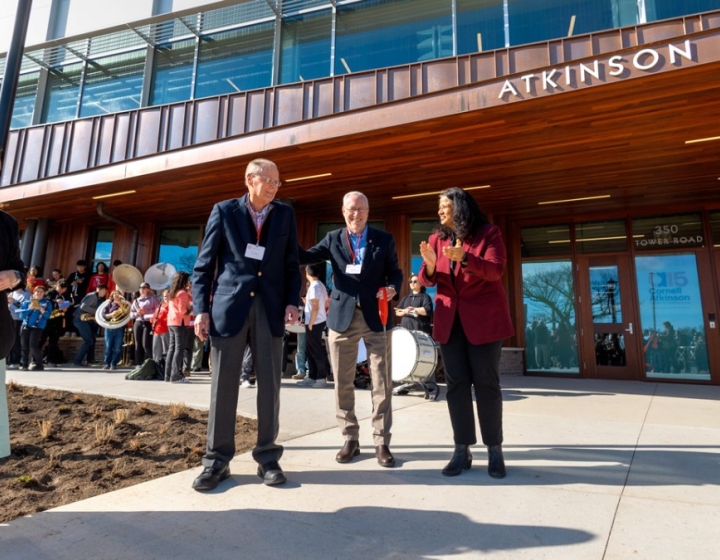Cornell veterinarians perform rare procedure to cure puppy's cardiac condition

Veterinarians from multiple countries joined forces to save a young German Shepherd’s life after a bundle of tissue in his heart turned deadly.
At six months old, Rex was by far the calmest dog the Silverman family had ever owned. Their other German Shepherds all bounced off the walls at that age, so at first they attributed Rex’s docile behavior to temperament.
“He was very low energy compared to the others,” said owner Karen Silverman. “I just thought he was lazy, that he liked to cuddle all the time instead.”
Nothing in his regular check-ups indicated a problem, but when Rex became violently ill in December of last year, the Silvermans noticed the dog’s heart was racing – and knew it was something far more serious.

Gretchen Singletary, a veterinary cardiologist in New York City, stabilized him and performed a series of tests, including an electrocardiogram. This confirmed the presence of an arrhythmia, a condition that causes the heart to beat abnormally.
The culprit: a small bundle of muscle running inside the wall of his heart, a defect Rex was born with and likely the cause of his low energy. Singletary told Silverman that Rex was a candidate for a procedure that can cure some arrhythmias in dogs – radiofrequency catheter ablation, where small areas of the heart muscle are heated through the tip of a catheter to destroy the abnormal tissue. Simple on paper, but not in practice. It is a complicated, precise procedure requiring a high level of skill. Further still, only two places in the United States even offer it routinely – a private practice in Ohio and the Cornell University Hospital for Animals (CUHA).
Once Silverman knew Rex had a chance at Cornell, she brought him to Ithaca that night. “I was going to do whatever it took,” she said.
Collaborations in cardiology
When Rex arrived at the Cornell University College of Veterinary Medicine in Ithaca, the cardiology team quickly controlled his skyrocketing heart rate and assessed the situation. They agreed – he needed the ablation, and only the right mix of medicine would keep his heart rate at normal levels until they could do the procedure.
“We knew the tachycardia would come back quickly if he didn’t have those medications,” said Romain Pariaut, associate professor in the Department of Clinical Sciences and section chief of cardiology at the hospital. Pariaut, a native of France, did his residency at Cornell and has been on faculty since September 2015.
Pariaut provided a detailed explanation of the procedure for Silverman’s seven year-old son, who knew him as Dr. France, said Silverman.
Soon they would add a Dr. Italy to the mix. Italian cardiologist and adjunct professor Roberto Santilli is one of the few veterinarians in the world who can perform the catheterization component of the ablation, which guides the catheters through the jugular and femoral veins and delivers the heat blasts to their target in the heart. Although Santilli was in Italy when Rex fell ill, he was able to rush to Ithaca five days after Rex first arrived. Together with Pariaut, members of the Cardiology Section, and a lineup of CUHA residents and students, this international dream team prepped the puppy for the procedure.

Precision procedure
While they knew what caused the arrhythmia, finding the exact location of the abnormal muscle bundle in Rex’s body was challenging. “It was difficult to spot the bundle, which is also known as accessory pathway,” said Pariaut, “and we were coming closer and closer to the atrioventricular (AV) node, which we didn’t want to damage.”
Damaging the AV node would be a serious complication that could affect Rex’s long-term quality of life and require a pacemaker, which have grim success rates for dogs his age. The Cornell team found that the bundle of tissue rested just next to this sensitive area. When Pariaut came to the waiting room to inform Silverman of the danger, she insisted they proceed.
With Santilli guiding the catheters and Pariaut signaling timed blasts to break up the accessory pathway, the doctors managed to burn the problematic area without damaging the nearby AV node.
“I knew they could do it,” said Silverman. “We had the greatest team. Everyone came together and made a miracle happen.”
Now that a few months have passed, the risk of that bundle of tissue returning to recreate the arrhythmia diminishes each day. Since then, the cardiologists at the hospital have re-examined his heart to confirm that it is beating normally. Rex’s heart is much stronger, according to Pariaut.
Silverman was enthusiastic about the success of the procedure. “Six hours later he came running down the hall, and the next day he came home with me,” she said. “It was the most amazing thing.”
For Rex, still not even a year old, he can now enjoy puppy life to the fullest. Within one month he was up to a healthy weight. In honor of his successful recovery and the surgeons who made it possible, the Silvermans partnered with the cardiology team to create the Henry and Karen Silverman Initiative to Advance Treatment of Canine Arrhythmias. Their intention is to further the study, diagnosis, and treatment of arrhythmias in dogs, as well as to educate pet owners and other veterinarians about these additional treatments for heart rhythm disorders.
“Now all he does is run,” said Silverman. “He finally has the energy to play.”

By Melanie Greaver Cordova
To make a gift to further this initiative, contact Amy Robinson at (607) 253-3742.




